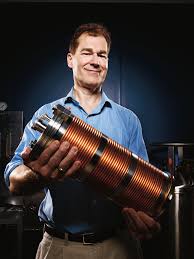From times immortal, water has always been a source of energy for mankind through its various applications. Life can not be dreamed-off without water. In the modern era of civilization with electric energy as a life line, water again plays an important role in providing electric energy through different capacity hydroelectric power plants where the potential energy head of water stored is used to convert it into electricity on the basis of Faraday’s law of electromagnetic induction. Hydroelectric power generation technology does have some limitations like high cost, people displacement problems and location specific. The fuel of the future could be hydrogen—if it can be made cheaply enough from water. Researchers are busy in devising less expensive methods for tapping the energy potential of this ubiquitous element. Currently, electrolyzers (machines that split water into its constituent hydrogen and oxygen) need a catalyst, namely platinum, to run; ditto fuel cells to recombine that hydrogen with oxygen, which produces electricity. The problem is that the precious metal costs about $1,700 to $2,000 per ounce, which means that hydrogen, would be an uneconomical fuel source unless a less costly catalyst can be found.
In new developments, Dr.Randell Mills, a Harvard-trained physician and founder of Black Light Power campany (USA) says that he has found water as an endless source of cheap energy. The technology is able to convert water into a boundless source of cheap energy but trouble is, scientists say that it (technology) violates the laws of quantum physics. It seems too good to be true: a new source of near-limitless power that costs virtually nothing and uses tiny amounts of water as its fuel and produces next to no waste. Dr. Mills claimed that he has created a working fuel cell using the world's most pervasive element: the hydrogen found in water. According to the inventor, it's proven technology, and he is going to commercialize it as quickly as possible. Mills developed the patented fuel cell having a solid fuel made of hydrogen and a sodium hydride catalyst - that enables the reaction to separate hydrogen from water. The fuel cell releases heat that turns water into steam, which drives electric turbines. It is based on a new chemical process of releasing the latent energy of the hydrogen atom with the formation of a prior undiscovered form of hydrogen called "hydrino". Hydrino is a new form of hydrogen, the simplest of all the atoms, with just a single proton circled by one electron. In "hydrino", the electron sits a little closer to the proton than normal, and the formation of the new atoms from traditional hydrogen releases huge amounts of energy.
Dr Mills's idea goes against almost a century of thinking. When scientists developed the theory of quantum mechanics they described a world where measuring the exact position or energy of a particle was impossible and where the laws of classical physics had no effect. The theory has been hailed as one of the 20th century's greatest achievements. The problem is that according to the rules of quantum mechanics, the physics that governs the behaviour of atoms, the idea is theoretically impossible. According to quantum mechanics, electrons can only exist in an atom in strictly defined orbits, and the shortest distance allowed between the proton and electron in hydrogen is fixed. The two particles are simply not allowed to get any closer. According to Dr Mills, there can be only one explanation: quantum mechanics must be re-formulated to explain such experimental findings. Existing of electrons in fixed orbits may have some other dimensions like flexible orbits under some special circumstance just like dual character of light in terms of its particle and wave nature. Dr Mills turned back to earlier classical physics to develop a theory which, unlike quantum mechanics, allows an electron to move much closer to the proton at the heart of a hydrogen atom and, in doing so, release the substantial amounts of energy he seeks to exploit.
Randell Mills claims to have built a prototype power source that generates up to 1,000 times more heat than conventional fuel. Independent scientists claim to have verified the experiments. The working models in the lab generate 50 kilowatts of electricity - enough to power six or seven houses which can be scaled to drive a large, electric power plant. The inventor claims this electricity will cost very less as compared to the existing electricity rates, thus advocating it as a cheap source of electric power. While the academic community stresses theoretical backing for this new discovery, the business world is more concerned with practical applications. It is believed that commercialization could lead more independent laboratories to validate BlackLight's claims. Theoreticians would like to understand it from an academic standpoint, while the theoretical tangle is unlikely to resolve itself soon, those wanting to exploit the technology are pushing ahead. The first product built with Blacklight's technology, which will be available in as little as four years, will be a household heater. As the technology is scaled up, bigger furnaces will be able to boil water and turn turbines to produce electricity.
Source: http://www.factsandarts.com, scientificamerican.com, blacklightpower.com money.cnn.com, wired.com, fsbfeatures, guardian.co.uk
